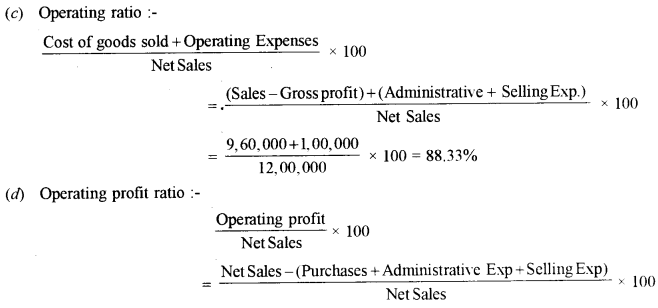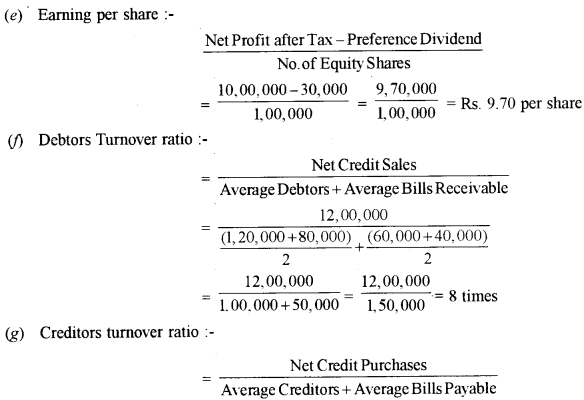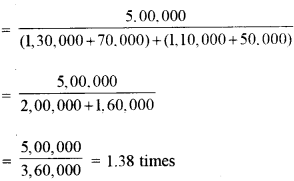ISC Accounts Previous Year Question Paper 2011 Solved for Class 12
Maximum Marks: 80
Time allowed: Three hours
- Candidates are allowed additional 15 minutes for only reading the paper. They must NOT start writing during this time.
- Answer Question 1 (Compulsory) from Part I and five questions from Part II, choosing two questions from Section A, two questions from Section B and one question from either Section A or Section B.
- The intended marks for questions or parts of questions are given in brackets [ ].
- Transactions should be recorded in the answer book.
- All calculations should be shown clearly.
- All working, including rough work, should be done on the same page as, and adjacent to the rest of the answer.
Part -1
Question 1.
Answer each of the following questions briefly : [10 x 2]
(i) How will you deal with the following items during the preparation of a cost sheet ?
(a) Salary of Public Relations Officer.
(b) Subscription to technical journals.
(ii) What journal entry will you pass w hen unsold stock is taken over by a Co-venturer assuming that a separate set of books is maintained ?
(iii) Which method of valuation of inventory will you recommend during:
(a) Periods of rising prices.
(b) Periods of falling prices.
(iv) State the entries you will pass in case of transfer from Debtors Ledger to Creditors Ledger under Self Balancing System.
(v) State two differences between average profits and super profits.
(vi) What are the closing entries for interest on calls in arrear account and interest on calls in advance account ?
(vii) State two differences bewtween current ratio and quick ratio.
(viii) List any two types of operating activities.
(ix) Explain the nature of interest on debentures.
(x) How will you deal with a situation when a solvent partner’s capital account reflects a debit balance in the application of Gamer Vs Murray ?
Answer :
(i) (a) The salary of a Public Relations officer is to be considered under the head Selling and Distribution overhead. As PRO is the officer who promotes the companies welfare and goodwill of the company.
(b) Subscription to technical journals will be considered under the head factory overheads. Technical journals arc used by the factory personnel, supervisors and technician
(ii) When unsold stock is taken over by a co-venturer the journal entry to be passed is
Co-Venturer A/c Dr
To Joint Venture A/e stock
(iii) (a) In the condition of rising prices FIFO gives greater profit than LIFO due to difference in the values of closing stock
(b) In the condition of falling prices LIFO gives greater profit than FIFO.
(iv) In the case of transfer under Self Balancing system the journal entries to be passed will be as follows assuming Mr. Singh as the person who is debtor as well as creditor for the common amount.
(a) Singh A/c Dr.
(in the purchase ledger)
To Singh A/c
(Balance of Singh a/c in the purchases ledger transferred to their a/c in the sales ledger)
(b) Purchases ledger adjustment A/c Dr.
(in General ledger)
To General ledger adjustment A c (in purchase ledger)
(Correcting entry of Adjustment Accounts for the transfer)
(c) General ledger adjustment A/c Dr
(in the sales ledger)
To Sales Ledger Adjustment A/c
(in the General ledger)
(Correcting entry of adjustment Accounts for the transfer)
(v)
| Average Profits | Super Profits |
| 1. It is (he average of profits of the past few years. 2. The normal rate of return is not relevant in the calculation of the average profits. | 1. It is excess of the average profits over the normal profits. 2. The normal rate of return is considered while calculating super profits. |
(vi) (i) On Transfer of interest on Calls – in – Arrears A/c to Profit and Loss A/c at the end of the accounting period.
Interest on calls in Arrears A/c Dr
To Profit and Loss A/c (With the amount of interest)
(ii)On transfer to P/L account at the end of accounting period.
Profit and Loss A/c Dr
To interest on Calls-in-advance A/c
(With the account of interest)
(vii)
| Current Ratio | Quick Ratio |
| 1. Current ratio relates current assets to current liabilities 2. Ideal ratio 2 : 1 | 1. Quick ratio relates quick assets to quick liabilities. 2. Ideal ratio 1 : 1 |
(viii) Two types of operating activities may be stated as :
- Cash receipts from sale of goods and sen ices.
- Cash receipts from royalties, fees, commission, etc
(ix) 1. No interest is payable on debentures issued as a collateral security.
2. The balance of interest on debentures account is transferred to the profit and loss account at the end of the year.
3. If the amount of interest accrued and due is not paid, it is known as Interest accrued and Due to interest outstanding. It appears under the head secured loans.
(x) When a solvent partner’s capital account reflects a debit balance in the application of Garner Vs Murray . The partner, having a debit balance, will not haw to bear the loss due to insolvency of a partner.
Question 2. [10]
The following information is available from the records of Singh and Company Limited for the month ended 30th September 2010 :
Purchases of raw materials — ₹ 1,00,000
Opening stock of finished goods (1000 units) — ₹ 13,600
Direct wages — ₹ 68,000
Factory overhead — ₹ 80% of direct wages
Administrative overhead — ₹ Rs. 2 per unit
Selling and Distribution overhead — ₹ R.s 1.50 per unit
Closing stock of finished goods —₹ 1.800 units
Royalties on production — ₹ 10,000
Sale of scrap of raw materials (normal loss) — ₹ 8,000
The manufacturer sells the product so as to reflect a profit of 25% on sales and 6200 units are sold in the market.
From the above information, you are required to prepare a Cost Sheet showing the total cost for the month ended 30th September 2010.
Note : All calculations are to be made to the nearest rupee and sales are made on the basis of LIFO principle.
Answer:
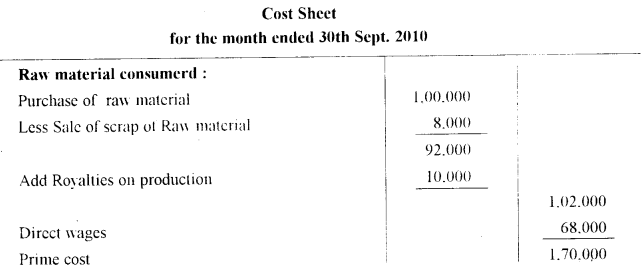
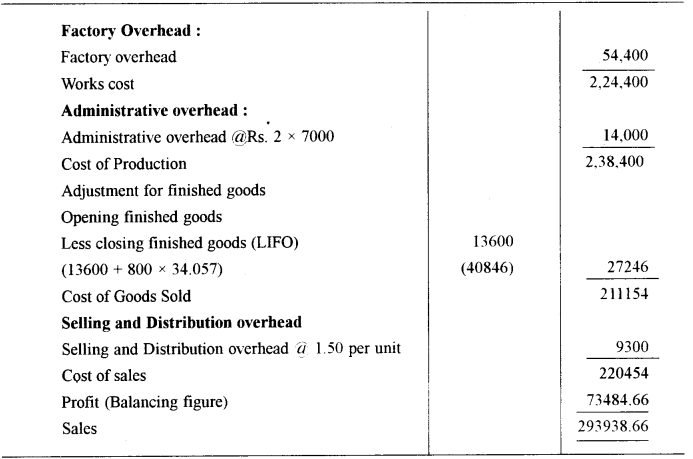

Part – II
Question 3. [14]
Roger and Suresh sharing profits and losses in the ratio of 3 : 2 jointly agreed to underwrite the subscription of 60,000 equity shares of Rs. 10 each of Parag and Company Limited at a premium of Rs. 3 per share. The underwriting commission is 4% as provided in the Articles. Applications were received from the public only for 40,000 shares and so the underwriters took over the remaining shares. A joint bank account was opened towards which Roger contributed Rs. 55.000 and Suresh Rs. 45,000. A sum of Rs. 7.000 was incurred on various expenses which were paid out of the joint bank account. Parag and Company paid the underwriting commission by cheque. At the close of the venture, the underwriters sold 12.000 shares at the rate of Rs. 15 per share and the rest of the shares were taken up by them at the rate of Rs. 14 per share, in their profit and loss sharing ratio.
Prepare :
(i) Joint Venture Account
(ii) Co-Venturers’ Account
(iii) Joint Bank Account
Answer:
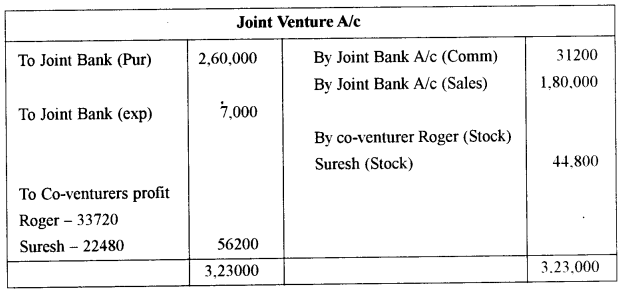
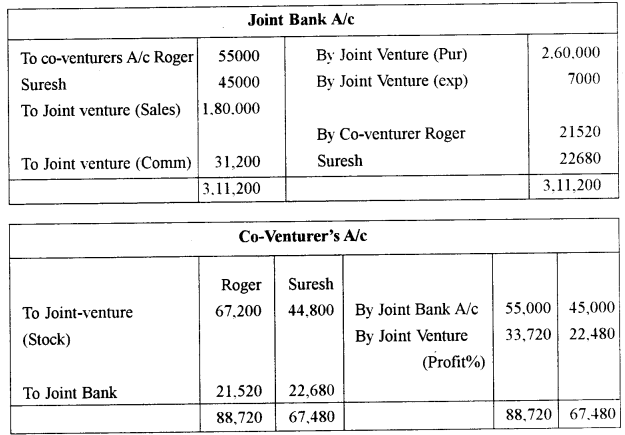
Question 4. [14]
Mr. Khanna maintains his books on sectional balancing ledgers.
Transactions during the month of November 2010 were :

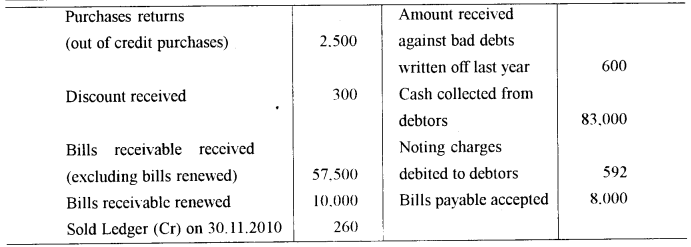
On 01.11.2010, Bought Ledger (Cr) Rs. 30.000 and Sold Ledger (Dr) Rs. 60.000.
From the above particulars, prepare Control Accounts in the relevant ledger.
Answer:
In Nominal Ledger
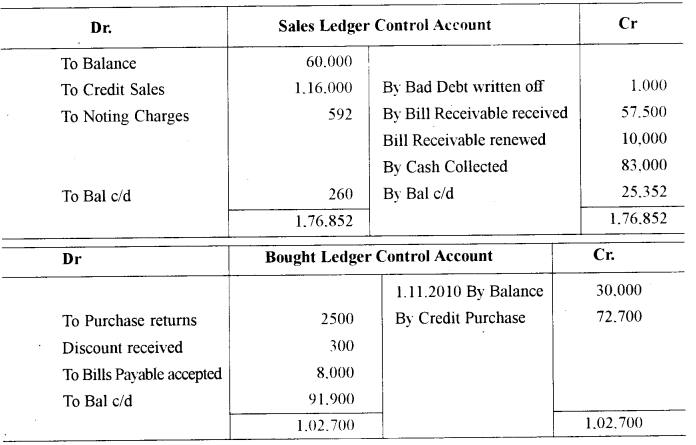
Question 5. [14]
Given below is the Balance Sheet of Gurmeet and Company Limited as on 31st December 2009 and 31st December 2010 :


(a) Investments costing Rs. 36,000 were sold for Rs. 30,000 during the year 2010.
(b) New debentures have been issued at the end of the current accounting year.
(c) New investments have been purchased at the end of the current accounting year.
(d) Depreciation charged on machinery during the current accounting year was Rs. 10,000.
From the above information prepare a Cash Flow Statement as per Accounting Standard-3.
Answer:
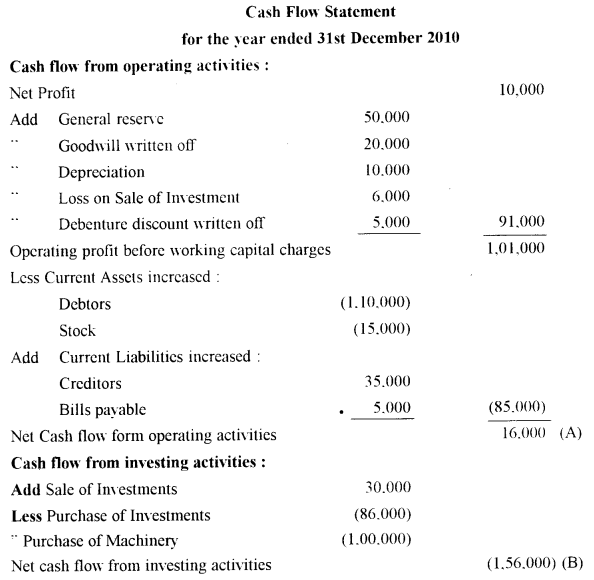

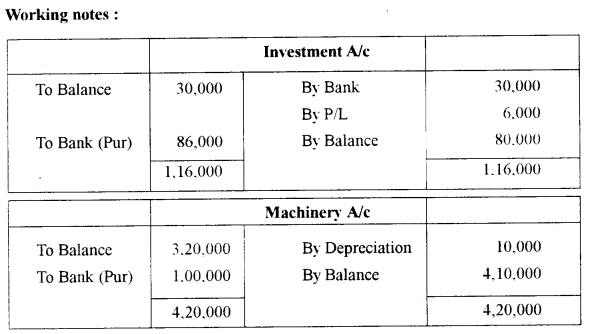
Question 6. [14]
Ahmed. Bina and Chitra are partners sharing profits and losses in the ratio of 3 : 2 : 1. Their balance sheet as on 31st March 2010 stood as under :
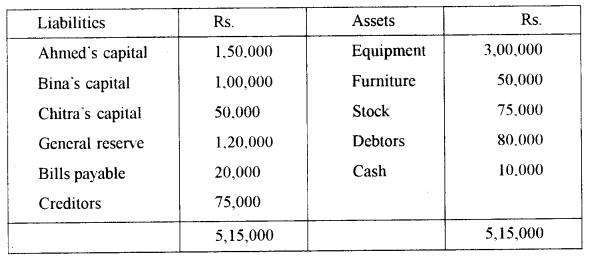
Ahmed died on 31.03.2010 and the following decisions were taken by the surviving partners according to the partnership deed :
(a) Equipment to be revalued at Rs. 3,50,000 and furniture to appreciate by Rs. 10,000.
(b) A provision of 10% to be created for doubtful debts.
(c) Stock to be revalued at Rs. 83,000.
(d) The goodwill of the firm was valued at Rs. 30,000 on Ahmed’s death.
The firm had a joint life policy of Rs. 90,000. The policy was surrendered and the death claim was realized in full by cheque from the insurance company.
The surviving partners finally agreed that the values of assets and liabilities must remain the same and as such, there must not be any change in their book values as a result of the above mentioned adjustments, excepting the bank balance.
The amount payable to Ahmed was transferred to his executor’s account.
Prepare Partners Capital Account and a Balance Sheet of Bina and Chitra.
Answer:
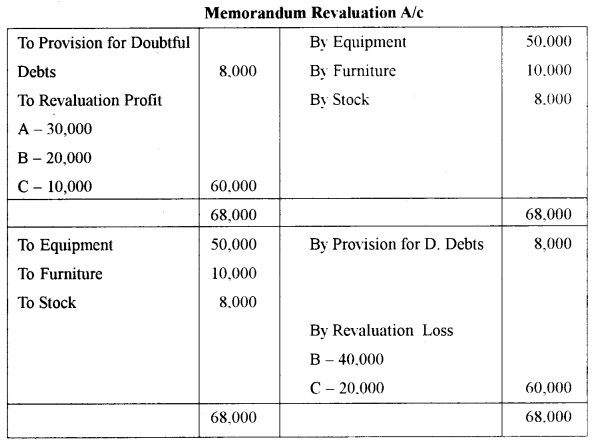
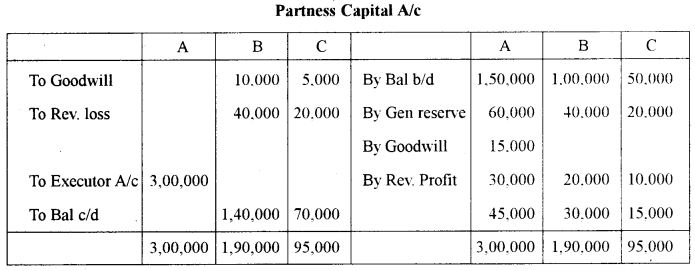

Question 7. [14]
Sachdeva Tyres and Company Limited issued applications for 100000 equity shares of Rs. 10 each at a premium of Rs. 3 per share. The amount was payable as follows.
(i) On application : Rs. 2 00
(ii) On allotment : Rs. 5 (including premium)
(iii) Balance on the first and the final call.
Applications were received for 150000 shares. Allotment was made pro-rata to all applicants. Sudhir who had applied for 300 shares failed to pay allotment and call money. His shares were forfeited after the first and the final call. Of these. 170 shares w ere reissued to Pramod at Rs. 9 per share fully paid.
Pass the necessary Journal Entries to show the above transactions. Show your w orkings clearly.
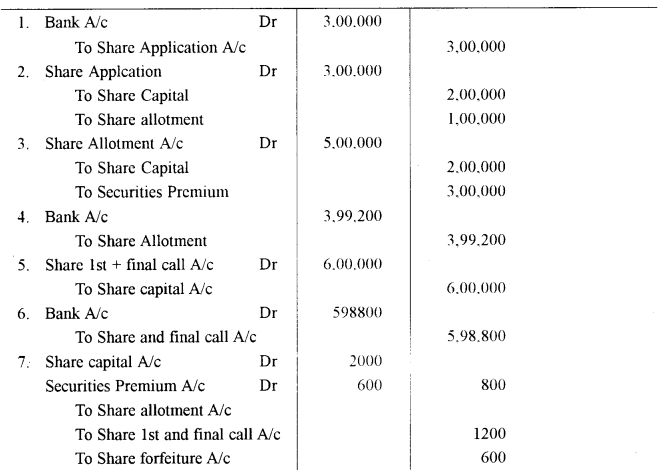

Question 8. [14]
(i) Gurung Ltd. took over assets of Rs. 6,00,000 and liabilities of Rs. 60,000 from Batra Ltd. for the purchase consideration of Rs. 5,50,000. It paid the purchase consideration by issuing 8% debentures of Rs. 100 each at 10% premium.
(ii) Gurung Ltd. purchased land from Jaiswal Ltd. for Rs. 4,50,000. The consideration was paid by issuing 5% debentures at a discount of 10%.
(iii) Gurung Ltd. issued 1,000, 6% debentures of Rs. 100 each at a discount of 7% repayable after 5 years at a premium of 10%.
From the above particulars, pass journal entries in the books of Gurung Ltd. to record the transactions.
Answer:
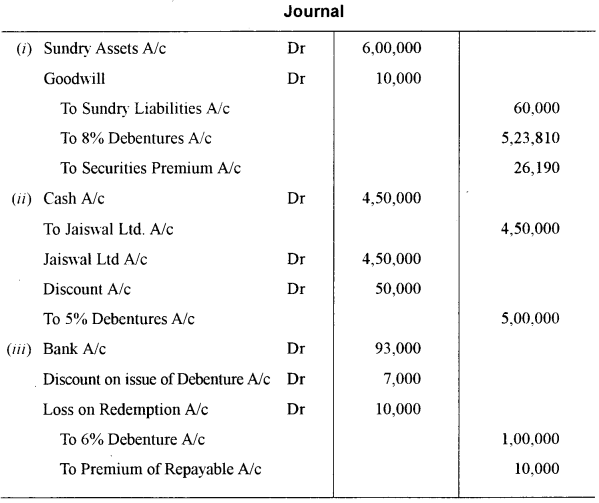
Question 9. [14]
David and Bimal are partners sharing profits and losses in the ratio 3:2. Their Balance Sheet as on 31st March 2010, was as follows :
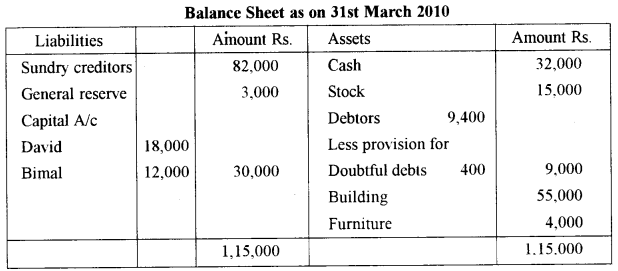
They admitted Chander as a new partner on 1.4.2010 and the new profit sharing ratio became 5:3:2. Chander introduced a capital of Rs. 16.000. Chander w as unable to bring any cash for good will and so it was decided to value the goodwill on the basis of his share in the profits and the capital contributed by him. The following revaluations were made at the time of Chander s admission :
(i) Stock had been overvalued by Rs. 750 and furniture by Rs. 500.
(ii) Provision for doubtful debts to be increased by Rs. 100.
(iii) A creditor for Rs. 2,350 was paid off by Bimal privately for which he was not to be reimbursed.
Prepare the Revaluation account, Partner’s capital accounts and a Balance Sheet of the new firm on the date of Chander’s admission. Show your workings clearly.
Answer:
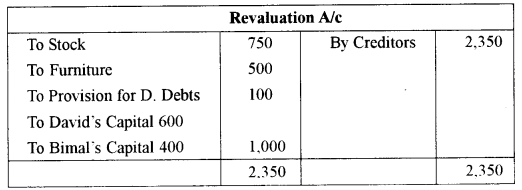


Question 10.
The following figures have been extracted from the books of Arvind and Company Limited
Net sales — Rs. 12,00,000
Net purchases — Rs. 5.00,000
Administrative expenses — Rs. 65.000
Selling and distribution expenses — Rs. 35.000
Gross profit — 20% on sales
Net profit after tax — Rs. 10,00,000
Total assets — Rs. 40,00,000
Equity share capital of Rs. 10 each — Rs. 10,00,000
10% Preference share capital of Rs. 10 each — Rs. 3,00,000
Reserves and surplus — Rs. 2,00,000
8% Debentures — Rs. 8,00,000
Opening debtors — Rs. 1,20,000
Closing debtors — Rs. 80,000
Opening bills receivable — Rs. 60,000
Closing bill receivable — Rs. 40,000
Opening creditors — Rs. 1,30,000
Closing creditors — Rs. 70,000
Closing bill payable — Rs. 50,000
Opening bills payable — Rs. 1,10,000
From the above information, calculate the following :
(a) Total assets to debt ratio
(b) Debt equity ratio
(c) Operating ratio
(d) Operating profit ratio
(e) Earning per share
(f) Debtors turnover ratio
(g) Creditors turnover ratio
Note : All calculations are to be made to two places of decimals.
Answer:

